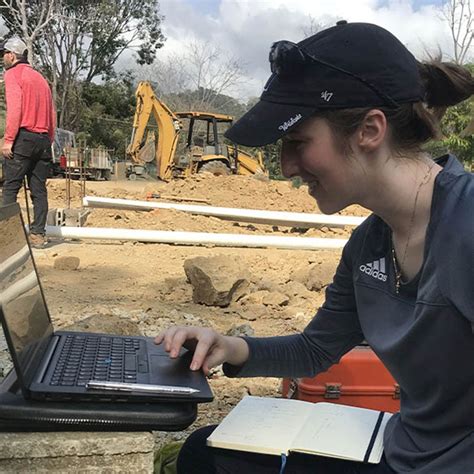In today’s ever-changing world, global challenges such as poverty, disease, natural disasters, and access to clean water and sustainable energy continue to impact communities all around the world. As the need for solutions to these challenges grows, the role of humanitarian engineering has become increasingly important. In this blog post, we will explore the concept of humanitarian engineering and its significance in addressing global challenges. We will also delve into the ways in which universities in the United States are taking on these challenges through their engineering programs, and the impact of their efforts on promoting sustainability and addressing critical issues. Additionally, we will examine successful case studies of humanitarian engineering projects and the collaborations between universities and non-governmental organizations. Finally, we will discuss the opportunities for student involvement and the role of research in finding innovative solutions, as well as the future prospects for humanitarian engineering in making a meaningful impact on the world.
Table of Contents
What is humanitarian engineering?
Humanitarian engineering is a field of study and practice that focuses on using engineering skills and principles to address the needs of underserved communities and improve quality of life. This type of engineering puts an emphasis on finding sustainable and innovative solutions to global challenges such as access to clean water, sanitation, healthcare, and infrastructure in developing countries and regions affected by natural disasters.
One of the key aspects of humanitarian engineering is the understanding of the social, cultural, and economic factors that play a role in the design and implementation of engineering projects. It involves working closely with communities to ensure that the solutions are tailored to their specific needs and that the projects are not only technically feasible but also socially and economically sustainable in the long run.
With a focus on using engineering for the greater good, humanitarian engineering also encourages the involvement of interdisciplinary teams, including professionals from fields such as public health, sociology, and environmental science, to ensure a holistic approach to problem-solving.
Overall, the goal of humanitarian engineering is to bridge the gap between technology and the most vulnerable communities, by leveraging the power of engineering to create positive and lasting impact on a global scale.
Why are global challenges important?
Global challenges are important because they directly impact the well-being and future of our planet and its inhabitants. These challenges, such as climate change, poverty, and access to clean water, are complex, interconnected, and require collaborative, innovative solutions to address them effectively. Ignoring or failing to tackle these challenges can have grave consequences for current and future generations.
Global challenges also present opportunities for creative problem-solving and technological advancements. By prioritizing these challenges, we can spur innovation and drive progress in various fields, including engineering, healthcare, and environmental sustainability. Additionally, addressing these challenges can foster international cooperation and solidarity, as they affect people across different countries and regions.
Furthermore, paying attention to global challenges is essential for promoting equity and social justice. Many of these challenges disproportionately affect marginalized communities and exacerbate existing inequalities. It is crucial to consider the impact of our actions on vulnerable populations and work towards solutions that are inclusive and equitable.
In conclusion, understanding the significance of global challenges is crucial for shaping a more sustainable, equitable, and prosperous future for all. By acknowledging their importance, we can mobilize resources, expertise, and collective action to address these challenges and create positive change on a global scale.
How do US universities tackle global challenges?
US universities play a crucial role in addressing global challenges through various initiatives and programs. One major way they tackle these challenges is through research and innovation. Universities invest a significant amount of resources in research aimed at finding solutions to global issues such as climate change, poverty, and healthcare disparities. Professors and researchers at these institutions collaborate on interdisciplinary projects that aim to address these challenges from different perspectives.
Another key approach US universities take in tackling global challenges is through international partnerships and collaborations. Many universities form partnerships with international organizations, other universities, and non-governmental organizations to work on global projects. These collaborations allow universities to pool resources, knowledge, and expertise to address complex global issues. Students also benefit from these partnerships by gaining hands-on experience through internships and fieldwork opportunities.
Furthermore, US universities promote global awareness and engagement among students through various programs and initiatives. Many universities offer courses and programs focused on global issues, encouraging students to learn about and engage with the world beyond their immediate surroundings. Additionally, universities often host events and conferences that bring together experts, scholars, and students to discuss and devise solutions for global challenges.
In addition to these efforts, US universities also emphasize the importance of social responsibility and ethical leadership in addressing global challenges. Many universities have established centers and institutes dedicated to promoting social entrepreneurship, sustainable development, and ethical leadership. These centers provide a platform for students, faculty, and industry experts to collaborate on practical solutions to global challenges.
The impact of humanitarian engineering programs
Humanitarian engineering programs have had a significant impact on addressing global challenges and improving the lives of communities in need. These programs use engineering principles to design and implement innovative solutions that address critical issues such as access to clean water, sanitation, sustainable energy, and infrastructure development in impoverished areas. Through the application of scientific and technological knowledge, humanitarian engineering programs aim to create sustainable and impactful solutions that can improve the quality of life for those in need.
One of the key impacts of humanitarian engineering programs is the improvement of health and well-being in communities. By providing access to clean water and sanitation, these programs help to reduce the spread of waterborne diseases and improve overall public health. Additionally, by focusing on sustainable energy solutions, such as clean cooking technologies and off-grid renewable energy systems, these programs can contribute to reducing household air pollution and improving the overall well-being of communities.
Furthermore, humanitarian engineering programs have a positive impact on economic development and poverty alleviation. By creating infrastructure and sustainable solutions for communities in need, these programs help to improve local economies and create opportunities for sustainable livelihoods. Additionally, access to clean water and sanitation can reduce the economic burden of waterborne diseases and improve productivity in communities, leading to greater economic opportunities and overall poverty reduction.
Overall, the impact of humanitarian engineering programs is far-reaching and plays a crucial role in addressing global challenges and improving the quality of life for individuals and communities in need. Through innovative engineering solutions, these programs are making a tangible difference in the world and contributing to creating a more sustainable and equitable future for all.
Promoting sustainability through engineering
Engineering plays a critical role in promoting sustainability in our world. Through innovative design and construction practices, engineers have the power to create solutions that minimize environmental impact and reduce resource consumption. By incorporating sustainable materials and energy-efficient technologies, engineers can contribute to the development of eco-friendly infrastructure that supports a more sustainable future for our planet.
One way that engineering can promote sustainability is through the implementation of renewable energy systems. By harnessing the power of solar, wind, and hydroelectric energy, engineers can create sustainable energy solutions that reduce our reliance on finite fossil fuels and mitigate the harmful effects of climate change. These renewable energy systems not only promote environmental sustainability but also have the potential to provide clean and affordable energy to communities around the world.
In addition to renewable energy, sustainable engineering also involves the design and construction of green buildings and infrastructure. Engineers can utilize environmentally friendly materials, such as recycled steel and sustainable wood, to construct buildings that minimize energy consumption and reduce waste. Furthermore, engineers can design infrastructure that effectively manages water resources, reduces pollution, and enhances biodiversity, all of which contribute to a more sustainable environment.
Overall, the role of engineering in promoting sustainability is essential for addressing the global challenges of climate change, resource scarcity, and environmental degradation. Through their expertise and creativity, engineers have the potential to drive positive change and create a more sustainable world for future generations.
Case studies of successful projects
Humanitarian engineering projects are making a real impact in communities around the world. These projects aim to address critical issues such as access to clean water, sanitation, and infrastructure. One example of a successful project is the implementation of a sustainable water supply system in a rural village in Africa. This project involved collaboration between engineers, local community members, and non-profit organizations, resulting in a reliable and long-term solution to the village’s water needs.
Another case study of a successful humanitarian engineering project is the development of low-cost, energy-efficient housing solutions in disaster-prone areas. This project not only provided safe and affordable housing for vulnerable populations but also contributed to long-term resilience and disaster preparedness. Through innovative design and community engagement, this project has improved the quality of life for countless individuals in at-risk communities.
In addition to addressing immediate needs, successful humanitarian engineering projects also focus on long-term sustainability. For example, a project that implemented a renewable energy system in a remote village not only provided immediate access to electricity but also empowered the community to maintain and expand the system, leading to economic development and improved quality of life.
These case studies demonstrate the effectiveness of humanitarian engineering in creating sustainable and impactful solutions to global challenges. By highlighting successful projects, we can inspire and motivate future engineers to continue tackling pressing issues and making a positive difference in the world.
Collaborations between universities and NGOs
Collaborations between universities and non-governmental organizations (NGOs) are crucial for addressing global challenges. These partnerships bring together the expertise and resources of academic institutions with the practical field experience and community connections of NGOs, leading to more effective and sustainable solutions.
By working together, universities and NGOs can leverage their respective strengths to tackle complex problems such as poverty, healthcare access, environmental conservation, and disaster relief. These collaborations often involve joint research projects, knowledge sharing, capacity building, and community engagement initiatives, resulting in real-world impact and positive change.
Furthermore, these partnerships provide valuable learning opportunities for students, who can gain hands-on experience, develop a deeper understanding of global issues, and contribute to meaningful projects. Many universities have established programs that facilitate student involvement in NGO collaborations, offering internships, volunteer opportunities, and fieldwork experiences.
Overall, the collaboration between universities and NGOs is an essential component of humanitarian engineering and global development efforts. By working together, these partners can drive innovation, foster sustainable solutions, and empower communities to build a better future.
Opportunities for student involvement
Student involvement in humanitarian engineering is crucial for fostering the next generation of global problem solvers. This field offers various opportunities for students to not only gain hands-on experience, but also to make a meaningful impact on communities around the world. By participating in projects and internships, students can apply their engineering skills to address real-world challenges while also learning about cultural differences and the complexities of sustainable development.
University-led initiatives often provide students with the chance to collaborate on interdisciplinary teams and work on projects that align with their interests. These initiatives may include research programs, social entrepreneurship competitions, or community outreach efforts. Through these opportunities, students can gain practical experience in implementing solutions to global challenges while also developing essential leadership, teamwork, and communication skills.
Furthermore, partnerships with non-governmental organizations (NGOs) and industry can create additional avenues for student involvement in humanitarian engineering. Whether through co-op programs, volunteering opportunities, or international internships, students can contribute to impactful initiatives and gain valuable insights into the practical applications of their engineering education. These partnerships also offer students the chance to network with professionals in the field and gain exposure to diverse perspectives and innovative approaches to problem-solving.
Lastly, student organizations and clubs focused on humanitarian engineering provide a platform for like-minded individuals to collaborate on projects, share knowledge, and advocate for social and environmental causes. These groups often organize events, workshops, and mentorship programs, allowing students to engage with peers and industry professionals, and further expand their understanding of global challenges and the role of engineering in addressing these issues.
The role of research in solving global challenges
Research plays a crucial role in addressing global challenges. Through rigorous investigation and analysis, researchers can gain a deep understanding of complex issues such as climate change, poverty, and public health crises. This knowledge serves as the foundation for developing innovative solutions that can have a lasting impact on communities worldwide.
Strong research initiatives are essential for identifying the root causes of global challenges. By studying the underlying factors that contribute to these issues, researchers can pinpoint areas where intervention is most needed. For example, in the case of environmental degradation, research can help in identifying the sources of pollution and its impact on ecosystems, which in turn can inform strategies for conservation and restoration.
Besides identifying problems and their causes, research also drives the development of effective interventions. By testing and refining potential solutions, researchers can determine the most efficient and sustainable methods for addressing global challenges. For instance, in the realm of public health, research is crucial for developing vaccines, treatments, and health education programs that can combat diseases and improve overall well-being.
Moreover, research helps in monitoring the progress and impact of interventions, allowing for adjustments and improvements over time. By collecting and analyzing data on the outcomes of various initiatives, researchers can assess their effectiveness and identify areas for enhancement. This iterative process is vital for ensuring that interventions remain relevant and adaptive to changing global circumstances.
Future prospects for humanitarian engineering
As the world continues to face unprecedented global challenges, the field of humanitarian engineering is becoming increasingly important. With the increasing globalization and interdependence of nations, the need for sustainable solutions to global problems has never been greater. This presents a unique opportunity for humanitarian engineers to make a significant impact on the world.
One of the future prospects for humanitarian engineering lies in the development of innovative technologies that can address critical issues such as access to clean water, sanitation, renewable energy, and affordable housing. These technological advancements have the potential to reshape the way humanitarian aid is delivered and make a lasting impact on communities in need.
Furthermore, as climate change continues to pose a threat to vulnerable populations around the world, there is an increasing need for humanitarian engineers to develop resilient infrastructure and disaster preparedness strategies to mitigate the impact of natural disasters. The future of humanitarian engineering will undoubtedly involve a focus on climate-resilient solutions that can protect communities from the adverse effects of a changing climate.
Another exciting prospect for humanitarian engineering is the growing emphasis on collaboration and partnerships between NGOs, government agencies, and the private sector. By working together, these stakeholders can leverage their respective strengths and resources to address complex global challenges in a more holistic and efficient manner, ultimately leading to more sustainable and impactful outcomes.






